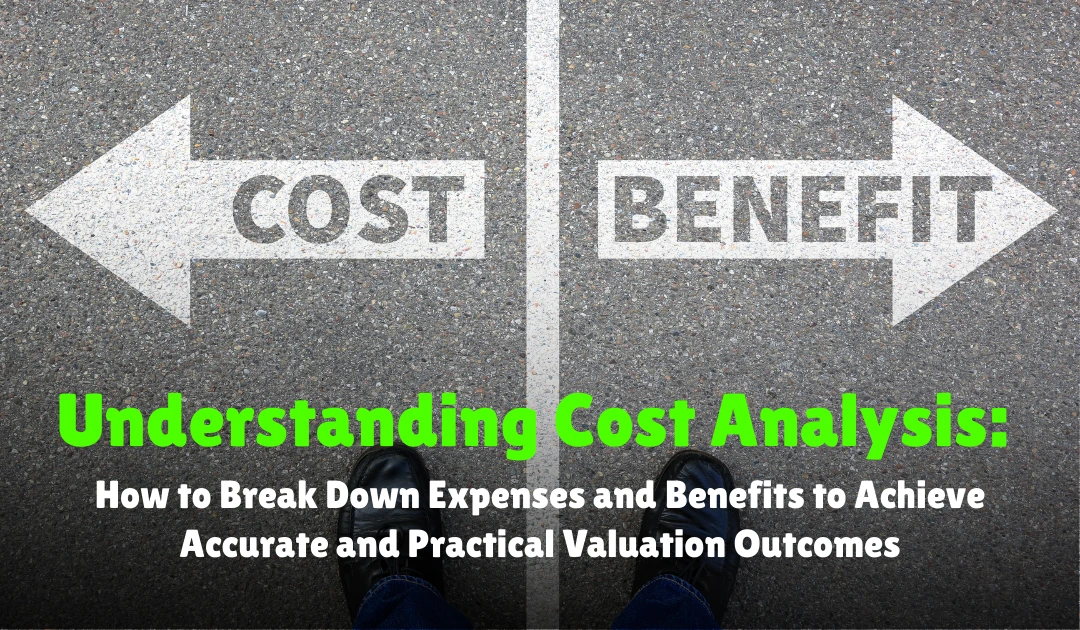Cost analysis is a critical component of property valuation, financial planning, and investment decision-making. By carefully examining the costs and benefits associated with a property, both buyers and lenders can make well-informed decisions that minimize risks and maximize value. Whether you are assessing residential holdings or a commercial property, a detailed cost analysis provides clarity on financial viability, expected returns, and potential pitfalls.
In this article, we will explore the fundamentals of cost analysis, its importance in property valuation, practical methods for breaking down expenses and benefits, and how accurate cost assessment contributes to effective decision-making.
What is Cost Analysis in Property Valuation?
Cost analysis is the process of evaluating all expenses related to a property and comparing them against potential benefits, such as rental income, resale value, or operational savings. It is not just a tally of expenditures; it involves examining the quality, efficiency, and long-term impact of each cost.
For a commercial property, cost analysis becomes even more critical because these properties involve higher investments, operational costs, and income considerations. By conducting a thorough analysis, investors, developers, and financial institutions can understand whether the property is worth acquiring, developing, or financing.
Why Cost Analysis Matters for Property Buyers and Investors
Understanding the cost structure and potential benefits of a property allows stakeholders to make decisions with confidence. Several advantages of performing a cost analysis include:
- Risk Mitigation: Helps identify hidden costs that could affect profitability.
- Informed Decision-Making: Buyers and lenders can assess whether a property justifies the investment.
- Budget Planning: Assists in estimating maintenance, taxes, and operational expenses.
- Maximizing Returns: Ensures potential benefits outweigh costs, particularly for commercial property investments.
Without a proper cost analysis, buyers may overpay, lenders may overextend loans, and investors could face unanticipated financial setbacks.
Key Components of Cost Analysis
A comprehensive cost analysis includes multiple components that collectively determine the financial health of a property investment. These components can be grouped into two main categories: expenses and benefits.
1. Expenses
- Acquisition Costs: Purchase price, legal fees, registration charges, and taxes associated with buying the property.
- Construction and Renovation Costs: Expenses related to building, improving, or modernizing the property.
- Operational Expenses: Regular costs such as utilities, security, insurance, and maintenance.
- Financing Costs: Interest payments, loan processing fees, and other banking charges.
- Depreciation and Obsolescence: Costs associated with aging infrastructure or outdated designs, which may reduce the property’s value over time.
2. Benefits
- Rental Income: For commercial property, projected rental earnings can significantly impact the overall valuation.
- Resale Value: Potential market appreciation if the property is sold in the future.
- Tax Incentives or Subsidies: Some properties qualify for tax benefits or government schemes.
- Operational Savings: Efficient systems or energy-saving features that reduce running costs.
Steps to Conduct an Effective Cost Analysis
Performing a cost analysis requires a structured approach to ensure accuracy and reliability. The following steps provide a practical framework:
- Identify All Costs and Benefits:
Begin by listing every potential expense and benefit related to the property, no matter how small. - Classify Costs:
Separate costs into categories such as fixed, variable, one-time, and recurring. This helps in understanding which expenses are predictable and which may fluctuate. - Estimate Monetary Values:
Assign realistic financial values to each cost and benefit. For commercial property, consider factors like market rental rates and anticipated occupancy levels. - Analyze Net Benefit or Loss:
Subtract total costs from total benefits to determine the net financial outcome. A positive result indicates a profitable investment, while a negative result signals potential financial risks. - Perform Sensitivity Analysis:
Assess how changes in key variables, such as interest rates, market demand, or operational costs, could affect overall valuation. This step is particularly important for commercial property investments that are sensitive to economic fluctuations.
Cost Analysis Techniques for Property Valuation
There are several methods and techniques used to conduct property cost analysis effectively:
- Comparative Method: Compare the costs and benefits of similar properties in the area to establish realistic benchmarks.
- Discounted Cash Flow (DCF): For commercial property, this method calculates the present value of expected future income streams against current costs.
- Replacement Cost Method: Determines the cost of replacing the property with a similar one, factoring in depreciation and current construction costs.
- Break-Even Analysis: Calculates the point at which total costs equal total benefits, helping to determine risk thresholds and investment feasibility.
Challenges in Cost Analysis for Property
While cost analysis is a powerful tool, it comes with its challenges:
- Market Volatility: Property values and rental income can fluctuate due to economic conditions.
- Hidden Costs: Unexpected expenses, such as legal disputes or structural issues, can impact outcomes.
- Data Accuracy: Inaccurate or outdated market data can lead to flawed analysis.
- Long-Term Uncertainty: Especially in commercial property, predicting future market trends, occupancy rates, or maintenance costs can be difficult.
These challenges highlight the importance of working with experienced valuers, financial analysts, and real estate professionals to ensure realistic and practical results.
The Role of Cost Analysis in Commercial Property Valuation
Commercial property investments involve higher stakes compared to residential properties, making cost analysis indispensable. Key considerations include:
- Income Generation Potential: Projected rental or business revenue can outweigh acquisition and operational costs.
- Capital Expenditure Planning: Renovation, expansion, and maintenance costs must be weighed against expected returns.
- Risk Assessment: Understanding market dynamics, tenant stability, and legal obligations reduces the risk of losses.
- Investment Decision Support: Accurate cost analysis informs lenders, investors, and business owners about the viability of commercial property purchases or financing.
By analyzing both costs and benefits meticulously, stakeholders can make strategic decisions that ensure profitability and sustainability.
Tips for Accurate and Practical Valuation Outcomes
- Use Reliable Data Sources: Real estate reports, government records, and professional appraisals improve accuracy.
- Include Long-Term Costs: Account for maintenance, renovations, and depreciation over the property’s lifespan.
- Consider Economic Trends: Interest rates, inflation, and market demand can affect costs and benefits.
- Engage Professional Experts: Valuers, accountants, and real estate consultants bring expertise to complex analyses.
- Regular Review: Re-evaluating property costs and benefits periodically helps maintain accurate valuations over time.
Conclusion
Cost analysis is an essential tool for anyone involved in property investment, mortgage financing, or valuation. By systematically breaking down expenses and evaluating benefits, buyers, lenders, and investors can achieve accurate and practical valuation outcomes.
For commercial property, where investment stakes are high and financial risks are significant, understanding cost analysis is particularly crucial. Accurate evaluation not only ensures a fair market transaction but also maximizes profitability and minimizes unforeseen challenges.
In today’s dynamic real estate market, cost analysis combined with professional valuation practices and market research provides the clarity and confidence needed to make sound property decisions. Whether acquiring residential homes or investing in commercial property, a well-executed cost analysis is a cornerstone of successful financial planning and strategic investment.


